

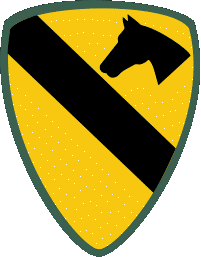 The 20th Engineers was reorganized and assigned to the 1st Cavalry Division as part of the Engineer Restructure Initiative. ERI (and its previous incarnation, E-Force) was a decade-long effort to improve the contribution of engineers on the forward edge of battle. Each mechanized infantry division and armored division was re-organized, from its old design of only a single divisional engineer battalion, to an Engineer Brigade with three battalions. As part of the ERI, the 20th Engineer Battalion was ordered to convert from a wheeled, Corps-level battalion, to a mechanized, division-level battalion. In June 1992, the 20th Engineers moved from Fort Campbell to Fort Hood, Texas, to become part of the
1st Cavalry Division. Company D was inactivated as part of the reorganization. The battalion commander that supervised the reorganization, Lt Col Joe Miller, gave the battalion its nickname, Lumberjacks, in honor of the forestry mission of the original 20th Engineers; the nickname is used to this day over tactical radio systems and everyday troop-speak.
The 20th Engineers was reorganized and assigned to the 1st Cavalry Division as part of the Engineer Restructure Initiative. ERI (and its previous incarnation, E-Force) was a decade-long effort to improve the contribution of engineers on the forward edge of battle. Each mechanized infantry division and armored division was re-organized, from its old design of only a single divisional engineer battalion, to an Engineer Brigade with three battalions. As part of the ERI, the 20th Engineer Battalion was ordered to convert from a wheeled, Corps-level battalion, to a mechanized, division-level battalion. In June 1992, the 20th Engineers moved from Fort Campbell to Fort Hood, Texas, to become part of the
1st Cavalry Division. Company D was inactivated as part of the reorganization. The battalion commander that supervised the reorganization, Lt Col Joe Miller, gave the battalion its nickname, Lumberjacks, in honor of the forestry mission of the original 20th Engineers; the nickname is used to this day over tactical radio systems and everyday troop-speak.
 The 1st Cavalry Division's 20th Engineers consisted of a Headquarters Company and three line companies, A, B, and C. Engineers were transported in M113 armored personnel carriers (APCs) instead of dump trucks; earthmoving tasks were performed by the M9 armored combat earthmover (ACE) instead of bulldozers; and bridges were emplaced by a tank-based armored vehicle launched bridge (AVLB) instead of constructed by brute labor. As part of III Corps and the 1st Cavalry Division, the 20th Engineers were among the first in the Army to gain a wide range of information age, digital technologies to improve battlefield effectiveness and combined arms integration. The 20th Engineers were normally employed as part of the division's 1st Brigade Combat Team; each of the 20th Engineer companies was designed so that it could be task organized to a maneuver task force, or could be employed under its parent battalion for major engineer operations.
The 1st Cavalry Division's 20th Engineers consisted of a Headquarters Company and three line companies, A, B, and C. Engineers were transported in M113 armored personnel carriers (APCs) instead of dump trucks; earthmoving tasks were performed by the M9 armored combat earthmover (ACE) instead of bulldozers; and bridges were emplaced by a tank-based armored vehicle launched bridge (AVLB) instead of constructed by brute labor. As part of III Corps and the 1st Cavalry Division, the 20th Engineers were among the first in the Army to gain a wide range of information age, digital technologies to improve battlefield effectiveness and combined arms integration. The 20th Engineers were normally employed as part of the division's 1st Brigade Combat Team; each of the 20th Engineer companies was designed so that it could be task organized to a maneuver task force, or could be employed under its parent battalion for major engineer operations.
In addition to yearly rotations to the National Training Center and other combined arms training, the 20th Engineers continued its long tradition of rapid response to the country's needs.
Firefighting Operations
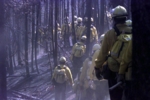
 In August 1994, under the command of Lt. Col. Bruce Porter (1994-1996), the 20th Engineers returned to its roots in the Forest, as it deployed as a task force headquarters to fight forest fires in the Boise National Forest, Idaho
(Idaho City Fire Complex). The battalion repeated this mission [pictures] in August 2000 in the Lolo National Forest, Montana. In both operations, the Lumberjacks performed with a level of distinction that would have made the Foresters of WW1 proud. Participants in each of the operations were awarded a Humanitarian Service Medal.
In August 1994, under the command of Lt. Col. Bruce Porter (1994-1996), the 20th Engineers returned to its roots in the Forest, as it deployed as a task force headquarters to fight forest fires in the Boise National Forest, Idaho
(Idaho City Fire Complex). The battalion repeated this mission [pictures] in August 2000 in the Lolo National Forest, Montana. In both operations, the Lumberjacks performed with a level of distinction that would have made the Foresters of WW1 proud. Participants in each of the operations were awarded a Humanitarian Service Medal.
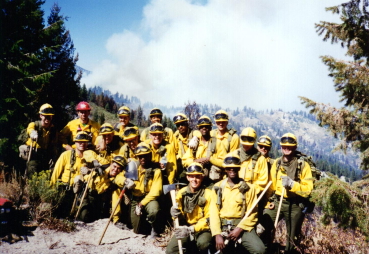
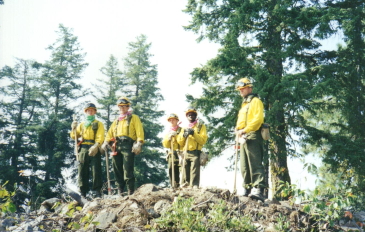
The Lumberjacks Return to Their Roots in the Forest
Operations in Northeast Asia - Korea
 In the Fall of 1995, under the command of Lt. Col. Bruce Porter (1994-1996), the battalion headquarters and Company C deployed with 2-8 Cavalry to the mountains of Korea as part of Operation Foal Eagle. The deployed soldiers trained ROK soldiers, learned the Korean landscape and culture, and honed their combined arms war-fighting skills.
In the Fall of 1995, under the command of Lt. Col. Bruce Porter (1994-1996), the battalion headquarters and Company C deployed with 2-8 Cavalry to the mountains of Korea as part of Operation Foal Eagle. The deployed soldiers trained ROK soldiers, learned the Korean landscape and culture, and honed their combined arms war-fighting skills.
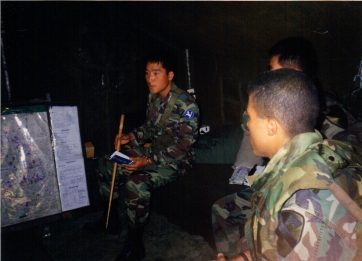
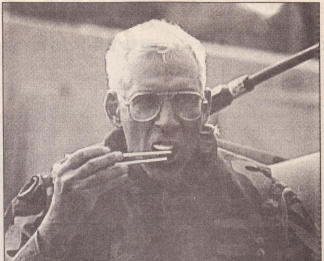
Operations in Southwest Asia - Kuwait
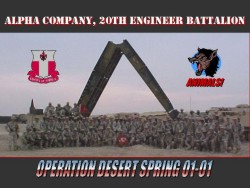
 In February 1997, Company C again deployed, this time with 1-7 Cavalry to the sands of Kuwait as part of Operation Sand Saber. The soldiers of Castle built ranges and trained with Kuwaiti soldiers, then redeployed in June 1997. Company A executed a similar operation in December 2000, as it deployed as part of Task Force 2-5 Cavalry in Operation Desert Spring. Those deploying to Desert Spring were awarded an Armed Forces Expeditionary Medal.
In February 1997, Company C again deployed, this time with 1-7 Cavalry to the sands of Kuwait as part of Operation Sand Saber. The soldiers of Castle built ranges and trained with Kuwaiti soldiers, then redeployed in June 1997. Company A executed a similar operation in December 2000, as it deployed as part of Task Force 2-5 Cavalry in Operation Desert Spring. Those deploying to Desert Spring were awarded an Armed Forces Expeditionary Medal.
Operations in Southern Europe - Bosnia
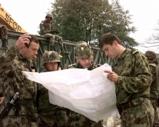
 In September 1998, under the command of Lt. Col. Bill Haight (1998-2000), the battalion deployed to Bosnia-Herzegovina to support peacekeeping operations
for Operation Joint Forge. Assigned to operate alongside 2-5 Cavalry, 1-8 Cavalry, and 2-8 Cavalry, the 20th Engineers was critical to the success accomplished during the deployment. The battalion conducted civil infrastructure reconstruction projects, identification of future areas for de-mining operations, and was a significant contributor in maintaining social stability within the conflicted society. Soldiers worked with both NATO and non-NATO allied forces (such as the Romanians in the photo to the left) in various projects such as reconnaissance, bridge construction, and bridge repair. Soldiers that deployed to Bosnia were awarded a NATO Medal.
In September 1998, under the command of Lt. Col. Bill Haight (1998-2000), the battalion deployed to Bosnia-Herzegovina to support peacekeeping operations
for Operation Joint Forge. Assigned to operate alongside 2-5 Cavalry, 1-8 Cavalry, and 2-8 Cavalry, the 20th Engineers was critical to the success accomplished during the deployment. The battalion conducted civil infrastructure reconstruction projects, identification of future areas for de-mining operations, and was a significant contributor in maintaining social stability within the conflicted society. Soldiers worked with both NATO and non-NATO allied forces (such as the Romanians in the photo to the left) in various projects such as reconnaissance, bridge construction, and bridge repair. Soldiers that deployed to Bosnia were awarded a NATO Medal.
The War in Iraq
In xxx of 2004, under the command of Lt. Col. Lawrence Barrett Holmes, the 20th Engineers deployed with the parent 1st Cavalry Division to the war in Iraq.
Click the image below to see the 20th Engineers in Iraq
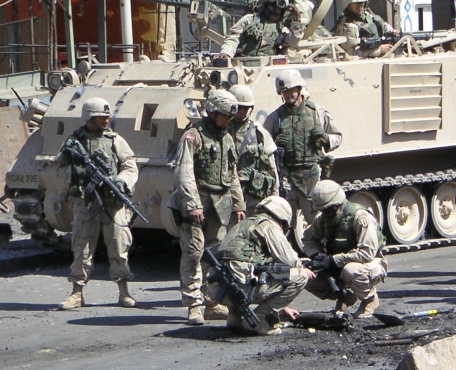
Return to Fort Hood and Inactivation
Shortly after the 20th Engineers' return from Iraq in 2005, the battalion was again ordered into a major reorganization. As part of the Army's Transformation, the battalion was inactivated. Two of the line companies of the 20th Engineers were assigned directly to maneuver battalions: Company A to 2nd Battalion, 8th Cavalry and Company B to 2nd Battalion, 5th Cavalry; and Company C was disbanded. The battalion headquarters became the base upon which the Special Troops Battalion of the 1st Brigade, 1st Cavalry Division was built.
Click the patch below to go to the next era of the 20th Engineers, Transformation and Modularity